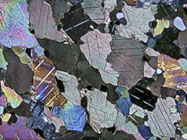|
Home
Page 1/3
Page 2/3
Page 3/3 (this page)



|
The origin of marble from ancient times: Gortyna (Crete)
webpage 3/3
Text: Annemieke van Roekel
Analyzing slides
For mineralogical and petrological analysis, flakes of a few square mm were taken from an
inconspicuous or invisible hidden side of about forty sculptures from the period of the 1st century
BC. to the 4th century AD. Most were produced in the 2nd and 3rd centuries AD, when the city grew
rapidly. Slides were examined with a polarizing microscope to determine structure and crystal size. Fig. 7ABC.
Powdered samples were examined by X-ray diffraction and their isotopes were examined.
The main petrographical properties of the marble (structure, crystal boundaries, maximum grain size
of the largest crystal, relative amount of accessory minerals) were compared with a reference list
of rock samples from ancient quarries prepared by the Venetian LAMA laboratory.



Fig. 7. Photomicrographs (crossed polars) of slides of the three typologies of Greek marble used for
manufacturing sculptures.
A. Pentelic marble: fine-grained calcite crystals with prevalently embayed boundaries; bottom picture:
potassic mica and rounded grains of quartz. B. Thasian marble, from Cape Vathy: dolomite crystals with sutured boundaries;
C. Paros marble (Lakkoi): calcite crystals with curved boundaries. FOV: 2.45 mm. Adapted from Antonelli et al., 2017.
Aegean region
Rock analysis resulted in the conclusion that all marble samples come from Greece;
more than half came from the marble quarries of Mount Pentelikon, near Athens. The columns of the
Parthenon also originate from the Pentelikon quarries.
The second most commonly used marble comes from the island of Thasos (Fig. 8) in the North Aegean
Sea, from the Cape Vathy quarries, conveniently located for transportation.
The third area of origin is the island of Paros: the Lakkoi quarries, the so-called Parian marble.

Fig. 8. Thasian marble as wavebreaker. Source: Lokal Profil via Wikimedia Commons CC-BY-SA-2.5
Acknowledgment
I want to thank Andreas Fischer-Happel (amateur historian from Schleswig-Holstein) for using his
photos, the tour in November 2021 in Gortyna and the right timing: sunset and a concert with sheep bells.
For (text) suggestions I am indebted to Bert Boekschoten, Tom van Loon and of course my colleagues from
the Gea editorial team.
References and more reading
- Antonelli, F., Bonetto, J., Lazzarini, L. et al. The use of white marbles
for sculpture in Roman Gortyn (Crete) as revealed by archaeometric analyses. Archaeol
Anthropol Sci 9, 579/589 (2017). doi.org/10.1007/s12520-016-0397-x
- Ben Russell. The Economics of the Roman Stone Trade. Oxford University Press, 2013.
- Plinius, De wereld. Naturalis historia. Athenaeum Polak & Van Gennep 2018.
- P. De Paepe, L. Moens en M. Waelkens. In het voetspoor van Aphrodite.
Een overzicht van vijf jaar natuurwetenschappelijk marmeronderzoek aan de Rijksuniversiteit Gent.
In: Tijdschrift voor Mediterrane Archeologie 1989, 2e jaargang nr.2.
Page 1/3
Page 2/3
Page 3/3
Top photo: Andreas Fischer-Happel.
Copyright: Annemieke van Roekel
Last update: July 16, 2022
|